Did you know that about 60% of small farmers do not make a profit? Now some of this is done through financial gimmickry at tax time, which is a whole other subject, but the vast majority of it is the result of two common misconceptions about how to make money, both of which are likely to be unpopular opinions. However, the smaller you farm, the smaller your margin for error. So these two things are going to be more important than some of us want to admit. I’m going to explain the problems first, then at the end of this post I’ll give you my solution, which will likely be unpopular as well.

Have you ever heard the joke that goes, “how do you make a million dollars farming? Start with 2 million.” While I understand the feelings being expressed in that joke, it is frequently told among a group of farmers standing around at a sale barn, getting ready to hand over the fruit of their labor to the corporate feed lots and packing companies.
The first problem that leads to farming failure is that you have to spend money to make money, specifically that you have to have to sink a lot of capital into depreciable assets.
While there are always going to be built in costs in any business, the problem here usually is the blurring of the line between needs and wants. I’ll be the first to admit that there are a lot of things that I want to do here. I’d like to buy tractors and trailers and equipment. I’d really like to have a nice squeeze chute and corral system.

Also, my half ton, light duty pickup really doesn’t have a whole lot of power. It would be nice to have a newer one. The point I’m trying to make here is that while all of that, and more, would be nice to have, I don’t need any of those things. My old stock trailer, antique tractors, rough old cattle panels, and used headgate get the job done just fine.
One of the most successful farmers I’ve known spent most of his life:
1. Getting by with what he had.
2. Borrowing what he didn’t have.
3. Hiring out the things that weren’t covered by the first two.
Sometimes we get caught up in this idealized picture of what farming is supposed to be. When we fall into that trap, we start forgetting that, at the end of the day, farming is a business. As much as I’d like to have some of the stuff I’d mentioned before, buying a bunch of equipment that I’ll only use once or twice a year doesn’t make sense.
Every purchase should be able to pay for itself in some way or another. Some purchases will do that faster than others, some slower.
But, at the end of the day, we have to be able to separate wants from needs.
The second problem that leads to financial failure for small farms, is thinking that if you don’t borrow money, you won’t have anything.
Farm debt was already considered to be at crisis levels before Covid, when people started spending money like they were printing it in the basement. When you buy something with borrowed money, the money you spend in interest each time you make a payment is money that is lost.

Many people make the argument that renting equipment or hiring something done is throwing money away because if you buy! the equipment, at least you get to keep it.
Well, here’s a thought, interest is rent you pay to the bank for something that you take sole responsibility for. Now, I’ll be the first to admit that I’ve been there and done that. My wife and I have been married for 19 years and we’ve made several bad financial decisions. We’ve bought trucks, tractors, and other toys, tools, and equipment with the bank’s money that I honestly wish I hadn’t.
Final thoughts…
The number of farmers in the US has been declining for several years. According to USDA statistics, the number of farms in the US peaked in 1935 at 6.8 million, and the average farm size was 155 acres. The country’s population was just over 127 million. That’s an average of roughly 1 farm per 18 people.
The most recent survey I found shows that there are only 2 million farms in the US, as of 2022. with a population of just over 333 million. The average farm size was 446 acres. That’s 1 farm for every 166 people. On one hand that’s an incredible feat, to think that so many people are being fed by each farm.
On the other hand, the continual decline in the number of farmers only serves to further centralize the US food system. A food system in which 85 percent of beef processed in the US is controlled by 4 companies.
Based on the average age of the American farmer, around 60 years old, there is going to be a large wealth transfer occurring over the next couple decades as the largest generation of American farmers (Baby Boomers) retire or pass away. This will go a couple different ways. Property will be bought up in very large tracts by large corporate farms, or in smaller tracts by small farmers who have been able to make sound financial decisions. Of course, many defeatists will argue that smaller farmers won’t be able to compete with those huge corporate farms and they may be right, to a point.
The good news for smaller farmers is that there has been a growing movement over the last few years to get back to a smaller, more community minded farming system. It’s becoming more and more about local food for local consumers. Those small farmers that are best able to keep inputs at a minimum are going to be primed for success in this new market. So, sound financial decision making is likely becoming more important than ever for small farmers.